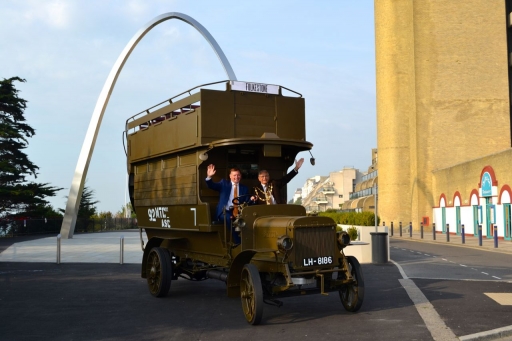London Transport Museum’s restored First World War bus has set off on a tour of the former battlefields of Flanders and France.
The open-top B-type bus, repainted in khaki, is in the Channel town of Folkestone today (September 18th 2014), at the start of a journey that also includes Ypres and the Somme.
Its first stop was the Step Short Arch on the Leas, opened by Prince Harry on August 4th 2014, the Centenary of Britain going to war, to commemorate the millions who travelled through Folkestone Harbour to the Western Front.
The commemorative tour will highlight the contribution and sacrifices made by London transport workers in the First World War.
It will also give the public an opportunity to find out more about the role of the 1000 London buses commandeered by Britain’s War Department to move troops during the conflict.
Tour destinations
From Folkestone, the ‘Battle Bus’ will travel through the Channel Tunnel, making stops at the following Belgian and French sites associated with London buses and the Great War:
*September 19th: Poperinge & Bus House Cemetery
*September 20th: Ypres (the ‘Battle Bus’ will take part in the Menin Gate ceremony. It will provide the backdrop to the buglers playing the Last Post after which Leon Daniels, Managing Director of Surface Transport at Transport for London will lay a wreath)
*September 21st: Zonnebeke
*September 23rd: Arras
*September 25th: Peronne
*September 26th: Albert
The bus will arrive at each venue with a special destination board made of tulip wood and carrying the name of the town; the board will later be presented to the local mayor to mark the commemorative visit.
Poignant
Sam Mullins, Director of London Transport Museum said, “The London bus drivers’ contribution to the war effort of 1914–1918 is a little known aspect of the First World War.
“Our centenary commemorative tour of the Battle Bus is made all the more poignant by knowing there is a red London bus beneath the wartime khaki ‘Battle Bus”.
The First World War was the first conflict to make use of motorised transport. The converted ‘Battle Buses’ would be driven to the Western Front, often by the same men who’d been at the wheel on the streets of London only weeks before.
The buses were camouflaged by removing advertisements and signage, boarding up the windows and painting the exterior khaki. Military markings were stencilled onto the body, War Department headlamps fitted and each bus was equipped with a pickaxe and shovel.
As London’s first standardised bus with interchangeable mechanical parts, damaged vehicles could more easily be salvaged for repairs.
Often the ‘Battle Bus’ drivers and mechanics would work under perilous conditions. William Mahoney, an army driver between 1916 and 1917 recalled “Bang! Crash!! Nearly on us. Nine men killed and 14 wounded only 50 yards away. My engine would not start so we had to stay and repair it, the shells pounding around us”.
The public will be able to find out more about the history of the ‘Battle Buses,’ and their contribution to the war effort, at a mobile exhibition accompanying the tour in town squares and at the Memorial Museum Passchendaele in Zonnebeke.
Source: London Transport Museum
Images courtesy of Rebecca McCutcheon/Folkestone Town Council
Posted by: Peter Alhadeff, Centenary News
